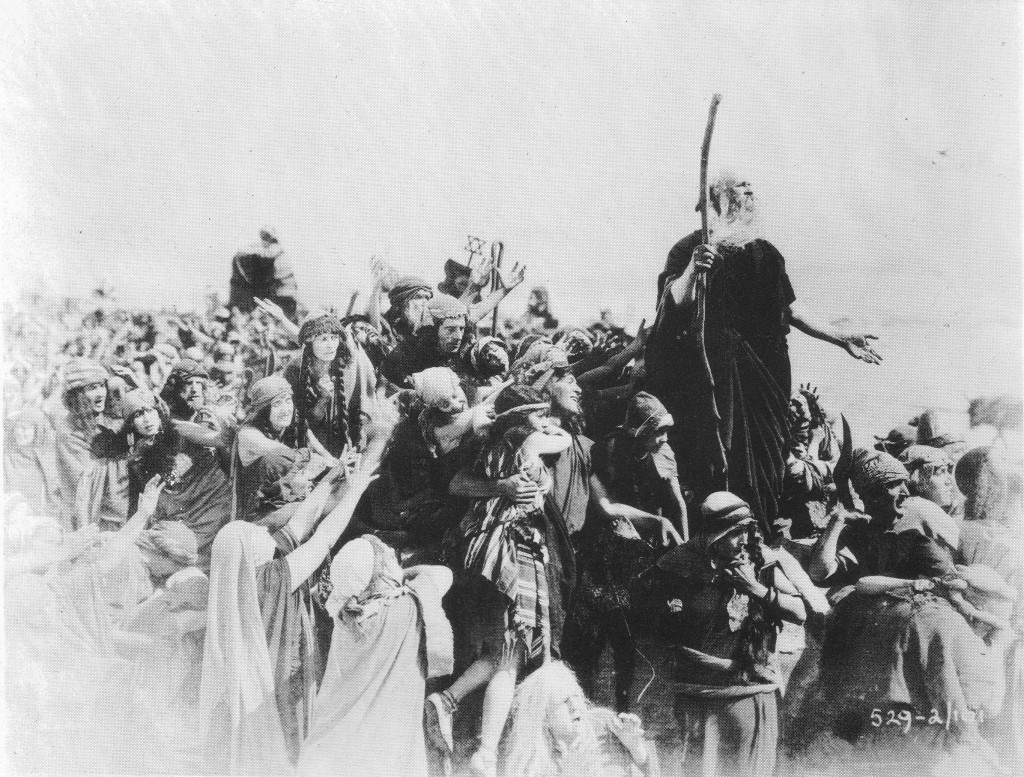 Tonight we’ll be screening an original IB Technicolor 35mm print of Cecil B. DeMille’s The Ten Commandments at the Portage. This 1956 epic is unequalled in its elemental power—its confusing mix of knotty, alien carnality and religious fervor has rightly frightened generations of children. (It’s also sufficiently iconic and hip enough to earn a nod in Arnaud Desplechin’s recent A Christmas Tale, alongside Nietzsche and Blackalicious.) But this four-hour spectacle wasn’t DeMille’s first attempt at bringing the Exodus to the screen. As a prologue to tonight’s festivities, we’re presenting a lengthy account of DeMille’s 1923 version. (To put that in some perspective, Charlton Heston was born in 1923.) Written in 2008, but previously unpublished, we hope you enjoy this article. And remember: You cannot break the Ten Commandments—they will break you. – Ed.
Tonight we’ll be screening an original IB Technicolor 35mm print of Cecil B. DeMille’s The Ten Commandments at the Portage. This 1956 epic is unequalled in its elemental power—its confusing mix of knotty, alien carnality and religious fervor has rightly frightened generations of children. (It’s also sufficiently iconic and hip enough to earn a nod in Arnaud Desplechin’s recent A Christmas Tale, alongside Nietzsche and Blackalicious.) But this four-hour spectacle wasn’t DeMille’s first attempt at bringing the Exodus to the screen. As a prologue to tonight’s festivities, we’re presenting a lengthy account of DeMille’s 1923 version. (To put that in some perspective, Charlton Heston was born in 1923.) Written in 2008, but previously unpublished, we hope you enjoy this article. And remember: You cannot break the Ten Commandments—they will break you. – Ed.
• • •
“Intolerance unfortunately was the picture really that broke [Griffith], because he made a dramatic error that should never be made,” remarked Cecil B. DeMille in 1958. “He told four stories under the guise of one, and consequently all four failed. Because that is a formula that so far as I know has never been successful on the stage. One-act plays can be successful but not … the same theme running through four separate stories as one play.” DeMille himself never made any film as structurally ambitious as Griffith’s masterwork but his first rendition of The Ten Commandments perhaps comes closest. Intrinsically bifurcated rather than mosaical, DeMille’s 1923 super-production nevertheless stands as one of the very few Intolerance descendants to seriously attempt anything resembling Griffith’s thematic integration of parallel spectacles.
DeMille embarked on his own ‘dramatic error’ after a string of failed pictures. The latest of them, Adam’s Rib, struck many critics as another unnecessary entry in that most frivolous of genres, the high-society marital farce, which DeMille had practically created in 1918 and had been more or less confined to working in ever since by the Famous Players-Lasky front office. Meanwhile epic pictures from Fairbanks’s Robin Hood to Universal’s The Hunchback of Notre Dame were brought to the screen in hopes of sating a public primed for expensive costume spectacles by German imports such as Lubitsch’s Madame DuBarry. Famous Players-Lasky even had the effrontery to let James Cruze, then a relative neophyte, spend $782,000 on The Covered Wagon while forcing its star director to hew to a formula of diminishing appeal. Unlike Griffith, DeMille’s screen career began with and paralleled the development of the feature, his name practically synonymous with a certain notion of middle-class entertainment. Producers everywhere now laid claim to an audience that DeMille had nurtured. DeMille insisted on entering the million-dollar picture race himself, which would mean working on a scale he had not been permitted since Joan the Woman of 1916.
